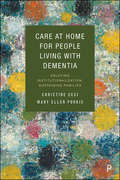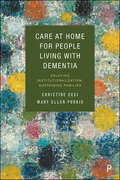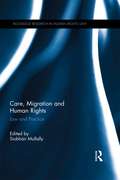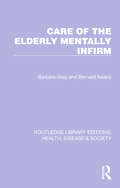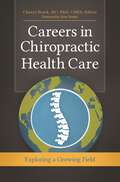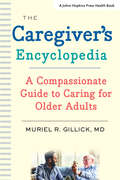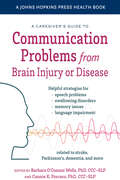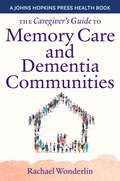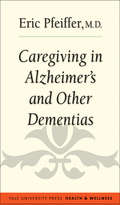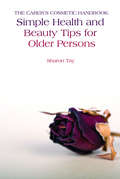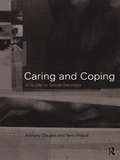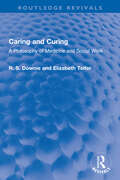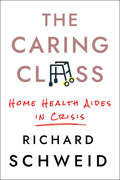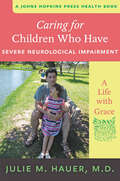- Table View
- List View
Care at Home for People Living with Dementia: Delaying Institutionalization, Sustaining Families
by Christine Ceci Mary Ellen PurkisWhat ‘kind’ of community is demanded by a problem like dementia? As aspects of care continue to transition from institutional to community and home settings, this book considers the implications for people living with dementia and their carers. Drawing on extensive fieldwork and case studies from Canada, this book analyses the intersections of formal dementia strategies and the experiences of families and others on the frontlines of care. Considering the strains placed on care systems by the COVID-19 pandemic, this book looks afresh at what makes home-based care possible or impossible and how these considerations can help establish a deeper understanding necessary for good policy and practice.
Care at Home for People Living with Dementia: Delaying Institutionalization, Sustaining Families
by Christine Ceci Mary Ellen PurkisWhat ‘kind’ of community is demanded by a problem like dementia? As aspects of care continue to transition from institutional to community and home settings, this book considers the implications for people living with dementia and their carers. Drawing on extensive fieldwork and case studies from Canada, this book analyses the intersections of formal dementia strategies and the experiences of families and others on the frontlines of care. Considering the strains placed on care systems by the COVID-19 pandemic, this book looks afresh at what makes home-based care possible or impossible and how these considerations can help establish a deeper understanding necessary for good policy and practice.
Care, Migration and Human Rights: Law and Practice (Routledge Research in Human Rights Law)
by Siobhán MullallyThe continuum of exploitation that has historically defined the everyday of domestic work - exclusion from employment and social security standards and precarious migration status – has frequently been neglected. It is primarily the moments of crisis, incidents of human trafficking, slavery or forced labour, that have captured the attention of human rights law. Only recently has human rights law has begun to address the structured inequalities and exclusions that define the domain of domestic work. This book addresses the specific position of domestic workers in the context of evolving human rights norms. Drawing upon a broad range of case studies, this book presents a thorough examination of key issues such as the commodification of care, the impact of the jurisprudence of the Court of Justice of the European Union and the European Court of Human Rights on ‘primary care providers’, as well as the effect that trends in migration law have on migrant domestic workers. This volume will be of interest to lawyers, academics and policy makers in the fields of human rights, migration, and gender studies.
Care, Migration and Human Rights: Law and Practice (Routledge Research in Human Rights Law)
by Siobhán MullallyThe continuum of exploitation that has historically defined the everyday of domestic work - exclusion from employment and social security standards and precarious migration status – has frequently been neglected. It is primarily the moments of crisis, incidents of human trafficking, slavery or forced labour, that have captured the attention of human rights law. Only recently has human rights law has begun to address the structured inequalities and exclusions that define the domain of domestic work. This book addresses the specific position of domestic workers in the context of evolving human rights norms. Drawing upon a broad range of case studies, this book presents a thorough examination of key issues such as the commodification of care, the impact of the jurisprudence of the Court of Justice of the European Union and the European Court of Human Rights on ‘primary care providers’, as well as the effect that trends in migration law have on migrant domestic workers. This volume will be of interest to lawyers, academics and policy makers in the fields of human rights, migration, and gender studies.
Care of the Elderly Mentally Infirm (Routledge Library Editions: Health, Disease and Society #14)
by Barbara Gray Bernard IsaacsOriginally published in 1979, this book explains why so many people suffer behavioural changes in later life; how this affects those around them; the services that exist to assist older people and those who work with them and how such services can be profitably used. A recurring theme is the interaction of the different varieties of mental illness with one another and with physical, emotional, social and personality factors. The book provides detailed guidance for social workers caring for the elderly on such topics as how an assessment of a mentally disturbed older person can be made; procedure for removal from home under a court order and compulsory admission to hospital; ways of communicating with elderly people and gauging the needs of relatives and carers.
Care of the Elderly Mentally Infirm (Routledge Library Editions: Health, Disease and Society #14)
by Barbara Gray Bernard IsaacsOriginally published in 1979, this book explains why so many people suffer behavioural changes in later life; how this affects those around them; the services that exist to assist older people and those who work with them and how such services can be profitably used. A recurring theme is the interaction of the different varieties of mental illness with one another and with physical, emotional, social and personality factors. The book provides detailed guidance for social workers caring for the elderly on such topics as how an assessment of a mentally disturbed older person can be made; procedure for removal from home under a court order and compulsory admission to hospital; ways of communicating with elderly people and gauging the needs of relatives and carers.
Careers in Chiropractic Health Care: Exploring a Growing Field
by Cheryl Hawk and John WeeksThis book provides potential students of a chiropractic career path, as well as other health care practitioners, with vital information regarding the training required to enter the chiropractic field and the roles of chiropractors in modern health care.Chiropractic is the second largest physician-level health profession in the United States, with chiropractors providing care to at least 20 million patients annually. As chiropractic health care has been proven to be both effective and cost effective for many musculoskeletal conditions, particularly back pain, the inclusion of Doctors of Chiropractic (DCs) in a variety of health care settings is likely to continue to increase. Surprisingly, there is little readily accessible information on chiropractic as a career path. This book provides concise yet comprehensive information about career paths, training, and professional roles in chiropractic for students considering chiropractic as well as health care practitioners in the field.Written in an easy-to-read style, Careers in Chiropractic Health Care: Exploring a Growing Field serves students, those in non-chiropractic health fields, and general readers considering chiropractic as a career change option. The chapters explain the training and specific licensure requirements for chiropractors in all 50 U.S. states and provide information useful to health care professionals for referrals and management of patients using chiropractic care.
Careers in Chiropractic Health Care: Exploring a Growing Field
by Cheryl HawkThis book provides potential students of a chiropractic career path, as well as other health care practitioners, with vital information regarding the training required to enter the chiropractic field and the roles of chiropractors in modern health care.Chiropractic is the second largest physician-level health profession in the United States, with chiropractors providing care to at least 20 million patients annually. As chiropractic health care has been proven to be both effective and cost effective for many musculoskeletal conditions, particularly back pain, the inclusion of Doctors of Chiropractic (DCs) in a variety of health care settings is likely to continue to increase. Surprisingly, there is little readily accessible information on chiropractic as a career path. This book provides concise yet comprehensive information about career paths, training, and professional roles in chiropractic for students considering chiropractic as well as health care practitioners in the field.Written in an easy-to-read style, Careers in Chiropractic Health Care: Exploring a Growing Field serves students, those in non-chiropractic health fields, and general readers considering chiropractic as a career change option. The chapters explain the training and specific licensure requirements for chiropractors in all 50 U.S. states and provide information useful to health care professionals for referrals and management of patients using chiropractic care.
The Caregiver's Encyclopedia: A Compassionate Guide to Caring for Older Adults (A Johns Hopkins Press Health Book)
by Muriel GillickCaregivers hold the key to the health, well-being, and happiness of their aging relatives, partners, or friends. The Caregiver's Encyclopedia provides you with all of the information you need to take the best care of your loved one—from making major medical decisions to making sure you don't burn out. Written by Muriel R. Gillick, MD, a geriatrician with more than 30 years' experience caring for older people, this book highlights the importance of understanding your friend's or family member's overall health. With compassion and expertise, this book will help you "think like a doctor." The content • helps you navigate the health-care system• shares important information about treating basic geriatric syndromes, including delirium, dementia, and falls• teaches you about preventive care options• enables you to manage medical decisions related to both acute and chronic conditions • discusses what Medicare covers—and what it doesn't• guides you through different approaches to care• weighs the risks and benefits of hospital vs. home, nursing home, or hospice care• provides a detailed list of medical supplies that you might want to keep on hand• offers you additional resources and emotional supportThroughout, Gillick provides helpful information and concrete concepts that caregivers can put into practice today. Authoritative, comprehensive, holistic, and highly illustrated, The Caregiver's Encyclopedia will help you figure out how to be the best caregiver you can be.
The Caregiver's Encyclopedia: A Compassionate Guide to Caring for Older Adults (PDF) (A Johns Hopkins Press Health Book)
by Muriel GillickCaregivers hold the key to the health, well-being, and happiness of their aging relatives, partners, or friends. The Caregiver's Encyclopedia provides you with all of the information you need to take the best care of your loved one—from making major medical decisions to making sure you don't burn out. Written by Muriel R. Gillick, MD, a geriatrician with more than 30 years' experience caring for older people, this book highlights the importance of understanding your friend's or family member's overall health. With compassion and expertise, this book will help you "think like a doctor." The content • helps you navigate the health-care system• shares important information about treating basic geriatric syndromes, including delirium, dementia, and falls• teaches you about preventive care options• enables you to manage medical decisions related to both acute and chronic conditions • discusses what Medicare covers—and what it doesn't• guides you through different approaches to care• weighs the risks and benefits of hospital vs. home, nursing home, or hospice care• provides a detailed list of medical supplies that you might want to keep on hand• offers you additional resources and emotional supportThroughout, Gillick provides helpful information and concrete concepts that caregivers can put into practice today. Authoritative, comprehensive, holistic, and highly illustrated, The Caregiver's Encyclopedia will help you figure out how to be the best caregiver you can be.
A Caregiver's Guide to Communication Problems from Brain Injury or Disease (A Johns Hopkins Press Health Book)
by Barbara O’Connor Wells, PhD, CCC-SLP and Connie K. Porcaro, PhD, CCC-SLPAn all-in-one guide for helping caregivers of individuals with brain injury or degenerative disease to address speech, language, voice, memory, and swallowing impairment and to distinguish these problem areas from healthy aging.Advances in science mean that people are more likely to survive a stroke or live for many years after being diagnosed with a degenerative disease such as Parkinson's. But the communication deficits that often accompany a brain injury or chronic neurologic condition—including problems with speech, language, voice, memory, and/or swallowing—can severely impact quality of life.If you are a caregiver coping with these challenges, this all-in-one book can help you and your loved one. Written by a team of experts in speech-language pathology, each chapter focuses on a different aspect of caregiving and features relatable patient examples. Providing answers to common questions, definitions of complex medical terms, and lists of helpful resources, this book also:• touches on expected, age-related changes in communication, memory, swallowing, and hearing abilities, to name a few• offers practical strategies for caregivers to cope with speech, language, and voice problems and to maximize their loved one's ability to communicate• reveals how caregivers can assist their loved ones with swallowing challenges to maintain good nutrition and hydration • provides crucial information on how caregivers can handle grief and take care of themselves during the caregiving process• explains how to incorporate the arts, as well as a loved one's hobbies and interests, into their communication or memory recoveryThis comprehensive book will allow readers to take a more informed and active role in their loved one's care.Contributors: Marissa Barrera, Frederick DiCarlo, Lea Kaploun, Elizabeth Roberts, Teresa Signorelli Pisano
A Caregiver's Guide to Communication Problems from Brain Injury or Disease (A Johns Hopkins Press Health Book)
by Barbara O'Connor Wells Connie K. PorcaroAn all-in-one guide for helping caregivers of individuals with brain injury or degenerative disease to address speech, language, voice, memory, and swallowing impairment and to distinguish these problem areas from healthy aging.Advances in science mean that people are more likely to survive a stroke or live for many years after being diagnosed with a degenerative disease such as Parkinson's. But the communication deficits that often accompany a brain injury or chronic neurologic condition—including problems with speech, language, voice, memory, and/or swallowing—can severely impact quality of life.If you are a caregiver coping with these challenges, this all-in-one book can help you and your loved one. Written by a team of experts in speech-language pathology, each chapter focuses on a different aspect of caregiving and features relatable patient examples. Providing answers to common questions, definitions of complex medical terms, and lists of helpful resources, this book also:• touches on expected, age-related changes in communication, memory, swallowing, and hearing abilities, to name a few• offers practical strategies for caregivers to cope with speech, language, and voice problems and to maximize their loved one's ability to communicate• reveals how caregivers can assist their loved ones with swallowing challenges to maintain good nutrition and hydration • provides crucial information on how caregivers can handle grief and take care of themselves during the caregiving process• explains how to incorporate the arts, as well as a loved one's hobbies and interests, into their communication or memory recoveryThis comprehensive book will allow readers to take a more informed and active role in their loved one's care.Contributors: Marissa Barrera, Frederick DiCarlo, Lea Kaploun, Elizabeth Roberts, Teresa Signorelli Pisano
The Caregiver's Guide to Memory Care and Dementia Communities (A Johns Hopkins Press Health Book)
by Rachael WonderlinThis practical guide provides general caregiving tips and helps you decide when and how to transition your loved one to a dementia care community.Caring for someone with dementia is challenging, especially when it comes time to think about other living arrangements. What do you need to know about dementia, including its different stages? What do you do if the person you're caring for seems to have trouble recognizing you? When is it time to move a person living with dementia into a senior living community? And how can you maintain your relationship with your loved one when you are living apart?Gerontologist and dementia care consultant Rachael Wonderlin has written a compassionate book to help friends and family members of those living with dementia answer these tough questions—and more. In practical, down-to-earth language, The Caregiver's Guide to Memory Care and Dementia Communities walks the reader through key points about dementia care, including • common terminology used by health care workers• strategies for taking care of your loved one• advice for when and how to transition to a dementia care community• understanding how dementia care communities are structured and what to keep in mind when evaluating them• how to help your loved one receive the best possible care while they're living apart• recommendations for handling obstacles involving communication and behavioral issues • information on technology, hospice care, programming and activities, and at-home safetyA dedicated section called "Putting It into Practice" in each chapter helps you apply the principles to your own experience, while worksheets present you with questions to consider as part of the caregiving and assessment process.
The Caregiver's Guide to Memory Care and Dementia Communities (A Johns Hopkins Press Health Book)
by Rachael WonderlinThis practical guide provides general caregiving tips and helps you decide when and how to transition your loved one to a dementia care community.Caring for someone with dementia is challenging, especially when it comes time to think about other living arrangements. What do you need to know about dementia, including its different stages? What do you do if the person you're caring for seems to have trouble recognizing you? When is it time to move a person living with dementia into a senior living community? And how can you maintain your relationship with your loved one when you are living apart?Gerontologist and dementia care consultant Rachael Wonderlin has written a compassionate book to help friends and family members of those living with dementia answer these tough questions—and more. In practical, down-to-earth language, The Caregiver's Guide to Memory Care and Dementia Communities walks the reader through key points about dementia care, including • common terminology used by health care workers• strategies for taking care of your loved one• advice for when and how to transition to a dementia care community• understanding how dementia care communities are structured and what to keep in mind when evaluating them• how to help your loved one receive the best possible care while they're living apart• recommendations for handling obstacles involving communication and behavioral issues • information on technology, hospice care, programming and activities, and at-home safetyA dedicated section called "Putting It into Practice" in each chapter helps you apply the principles to your own experience, while worksheets present you with questions to consider as part of the caregiving and assessment process.
Caregiving in Alzheimer's and Other Dementias (Yale University Press Health & Wellness)
by Eric PfeifferPractical. Easy to read. Comprehensive. Encouraging. Accurate. All of these words describe this indispensable book that belongs in the hands of all family members and other caretakers of people who have been diagnosed with Alzheimer’s disease or other dementias. Dr. Eric Pfeiffer, a physician who has devoted thirty years to patients suffering from all forms of dementia, here distills the wisdom of those years for the benefit of caregivers confronting some of life’s most challenging days. Dr. Pfeiffer’s genuine compassion and wise advice are certain not only to reduce caregiver stress but also to improve the patient’s quality of life. In these pages are specific tips for all stages of caregiving, from the initial realization of the problem through mild, moderate, and severe stages of dementia, and even beyond, when a caregiver begins to resume a full life after the patient’s death. Dr. Pfeiffer identifies specific problems and provides practical solutions. He explains the importance of support groups and many other means of dealing with stressful days. For experienced caregivers and those new to the challenges, this book will be a profoundly useful guide to coping successfully.
The Carer's Cosmetic Handbook: Simple Health and Beauty Tips for Older Persons (PDF)
by Sharon TayMaintaining a healthy appearance and good hygiene is an important factor in a person's sense of wellbeing. As people age, this does not diminish but the body becomes more sensitive and deserves to be treated in a different way. This practical handbook is specifically designed to assist carers in looking after their clients' appearances as well as their health, providing a wealth of information on health and beauty care for older people. Throughout the book, Sharon Tay, an experienced beauty therapist, gives detailed and easy to follow instructions on appropriate cosmetic techniques such as manicures, pedicures, herbal remedies, hair removal, skin care and makeup application. These techniques avoid damaging treatments and the overuse of harmful products that often cause unwanted skin, nail and hair problems. Question and answer sections are also included, highlighting some of the common concerns and queries. Brimming with beauty and health care tips, this book is ideal for carers looking to improve quality of life for their clients and will also be of interest to anyone needing advice on sensitive beauty treatments.
Cargo pants and denim shorts (large print)
by RnibThere are two images of women's clothing on this page: a pair of cargo pants on the left of the page and a pair of denim shorts on the right. They are seen from the front. The trousers' waistbands are at the top of the images and their hems at the bottom. There is a locator dot shown, which will be at the top left of the page when the image is the correct way up. The cargo pants are tightly fitted at the waist and then fall straight and loose to the ankle, where they are slightly gathered. They are made from a heavy cotton fabric and have a military style with cargo pouch pockets on the side of each thigh. They have two slanted side pockets and a zip fly. The denim shorts are styled like a pair of blue jeans that have been cut off at mid-thigh and turned up to make cuffs. Sometimes the fabric is left to fray at the cut-off to give the shorts a vintage, distressed appearance. They have two patch pockets on the rear with two slanted side pockets and a zip fly.
Cargo pants and denim shorts (UEB contracted)
by RnibThere are two images of women's clothing on this page: a pair of cargo pants on the left of the page and a pair of denim shorts on the right. They are seen from the front. The trousers' waistbands are at the top of the images and their hems at the bottom. There is a locator dot shown, which will be at the top left of the page when the image is the correct way up. The cargo pants are tightly fitted at the waist and then fall straight and loose to the ankle, where they are slightly gathered. They are made from a heavy cotton fabric and have a military style with cargo pouch pockets on the side of each thigh. They have two slanted side pockets and a zip fly. The denim shorts are styled like a pair of blue jeans that have been cut off at mid-thigh and turned up to make cuffs. Sometimes the fabric is left to fray at the cut-off to give the shorts a vintage, distressed appearance. They have two patch pockets on the rear with two slanted side pockets and a zip fly.
Cargo pants and denim shorts (UEB uncontracted)
by RnibThere are two images of women's clothing on this page: a pair of cargo pants on the left of the page and a pair of denim shorts on the right. They are seen from the front. The trousers' waistbands are at the top of the images and their hems at the bottom. There is a locator dot shown, which will be at the top left of the page when the image is the correct way up. The cargo pants are tightly fitted at the waist and then fall straight and loose to the ankle, where they are slightly gathered. They are made from a heavy cotton fabric and have a military style with cargo pouch pockets on the side of each thigh. They have two slanted side pockets and a zip fly. The denim shorts are styled like a pair of blue jeans that have been cut off at mid-thigh and turned up to make cuffs. Sometimes the fabric is left to fray at the cut-off to give the shorts a vintage, distressed appearance. They have two patch pockets on the rear with two slanted side pockets and a zip fly.
Caring and Coping: A Guide to Social Services
by Anthony Douglas Terry PhilpotCaring and Coping provides a clear and accessible explanation of the history, politics, management, funding and day-to-day work of the social services in Britain. Social Care now encompasses a wide range of increasingly specialised professions. Caring and Coping aims to improve the practitioner's (and the general public's) understanding not only of what these various professions do, but also what the legal, political, ethical and financial constraints are upon them. It succinctly addresses issues such as:* the terms and effects of the Children Act and the Community Care Act* the role of charities in the modern welfare state* the role of management* relationships with other agencies* and the place of social work within the community. Social services are so often portrayed in the media in a sensationalist way and this book counterbalances the hype by providing solid research and a more down-to-earth picture. It is an ideal introductory text for those training to be social workers.
Caring and Coping: A Guide to Social Services
by Anthony Douglas Terry PhilpotCaring and Coping provides a clear and accessible explanation of the history, politics, management, funding and day-to-day work of the social services in Britain. Social Care now encompasses a wide range of increasingly specialised professions. Caring and Coping aims to improve the practitioner's (and the general public's) understanding not only of what these various professions do, but also what the legal, political, ethical and financial constraints are upon them. It succinctly addresses issues such as:* the terms and effects of the Children Act and the Community Care Act* the role of charities in the modern welfare state* the role of management* relationships with other agencies* and the place of social work within the community. Social services are so often portrayed in the media in a sensationalist way and this book counterbalances the hype by providing solid research and a more down-to-earth picture. It is an ideal introductory text for those training to be social workers.
Caring and Curing: A Philosophy of Medicine and Social Work (Routledge Revivals)
by Robert (R. Downie Elizabeth TelferFirst published in 1980, Caring and Curing is for all those involved in the ‘caring professions’ – medicine, social work, and the other health and welfare occupations. It is both an introduction to philosophy for the caring professions and a philosophy of those professions. The authors believe that the best way to introduce philosophy is to engage in it, to philosophize, and that the most exciting way to philosophize is to offer a reasoned but controversial point of view on matters to which people are professionally committed. They argue, first, that there is an essential unity of the caring professions in that the concepts of health and welfare are different aspects of a single value judgement as to what sort of life a person should be enabled to live in his society. Secondly, they show the limits of scientific expertise in relation to human behaviour and argue that the education of medical and social workers should include broader humane disciplines to assist them in coping with the problems of ethics and values of all kinds in present-day society. Thus, the discussion introduces the main branches of philosophy and deals with many of the current moral dilemmas in medicine and social work.
Caring and Curing: A Philosophy of Medicine and Social Work (Routledge Revivals)
by Robert (R. Downie Elizabeth TelferFirst published in 1980, Caring and Curing is for all those involved in the ‘caring professions’ – medicine, social work, and the other health and welfare occupations. It is both an introduction to philosophy for the caring professions and a philosophy of those professions. The authors believe that the best way to introduce philosophy is to engage in it, to philosophize, and that the most exciting way to philosophize is to offer a reasoned but controversial point of view on matters to which people are professionally committed. They argue, first, that there is an essential unity of the caring professions in that the concepts of health and welfare are different aspects of a single value judgement as to what sort of life a person should be enabled to live in his society. Secondly, they show the limits of scientific expertise in relation to human behaviour and argue that the education of medical and social workers should include broader humane disciplines to assist them in coping with the problems of ethics and values of all kinds in present-day society. Thus, the discussion introduces the main branches of philosophy and deals with many of the current moral dilemmas in medicine and social work.
The Caring Class: Home Health Aides in Crisis (The Culture and Politics of Health Care Work)
by Richard SchweidThe number of elderly and disabled Americans in need of home health care is increasing annually, even as the pool of people—almost always women—willing to do this job gets smaller and smaller. The Caring Class takes readers inside the reality of home health care by following the lives of women training and working as home health aides in the South Bronx.Richard Schweid examines home health care in detail, focusing on the women who tend to our elderly and disabled loved ones and how we fail to value their work. They are paid minimum wage so that we might be absent, getting on with our own lives. The book calls for a rethinking of home health care and explains why changes are urgent: the current system offers neither a good way to live nor a good way to die. By improving the job of home health aide, Schweid shows, we can reduce income inequality and create a pool of qualified, competent home health care providers who would contribute to the well-being of us all. The Caring Class also serves as a guide into the world of our home health care system. Nearly 50 million US families look after an elderly or disabled loved one. This book explains the issues and choices they face. Schweid explores the narratives, histories, and people behind home health care in the United States, examining how we might improve the lives of both those who receive care and those who provide it.
Caring for Children Who Have Severe Neurological Impairment: A Life with Grace (A Johns Hopkins Press Health Book)
by Julie M. HauerGlobal impairment of the central nervous system, whether stable or progressive, is often called severe neurological impairment (SNI). A child who has SNI will be cared for both by specialist clinicians and by parents at home. A parent is a child’s best expert and advocate, and many parents become highly skilled in managing their child's care. This guide provides information to help parents increase their knowledge and improve their caregiving skills. In Caring for Children Who Have Severe Neurological Impairment, Dr. Julie M. Hauer advocates shared decision making between family caregivers and healthcare providers. She details aspects of medical care such as pain, sleep, feeding, and respiratory problems that will be particularly useful to parents. Tables and key points summarize discussions for clear, quick reference, while case studies and stories illustrate how different families approach decision making, communication, care plans, and informed consent.Parents and other caregivers will find this book to be indispensable—as will bioethicists and clinicians in pediatrics, neurology, physical and rehabilitative medicine, palliative care, and others who care for children with neurological and neuromuscular disorders. Dr. Hauer offers hope and practical coping strategies in equal measure.
